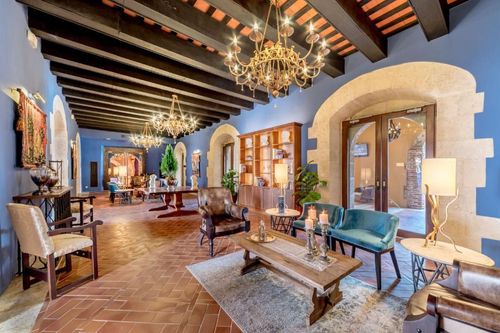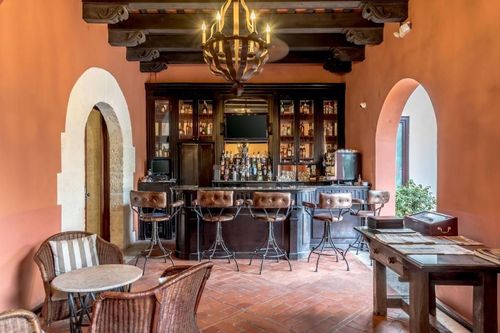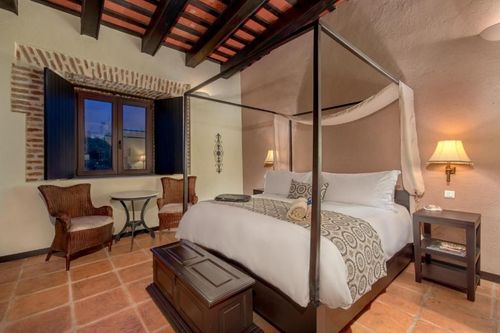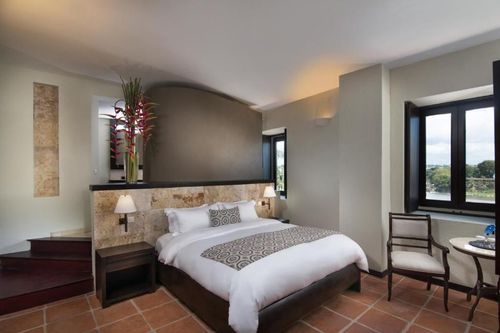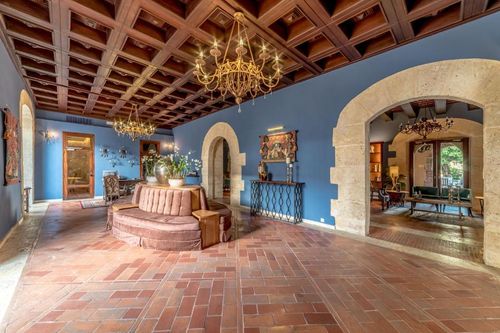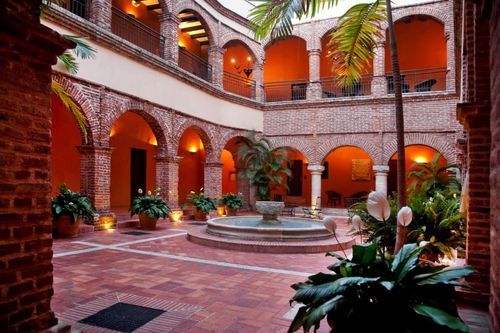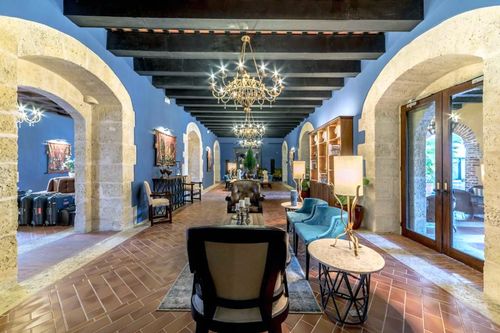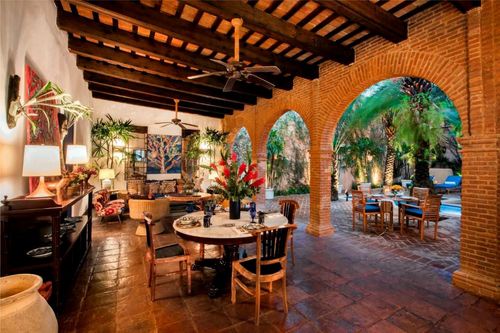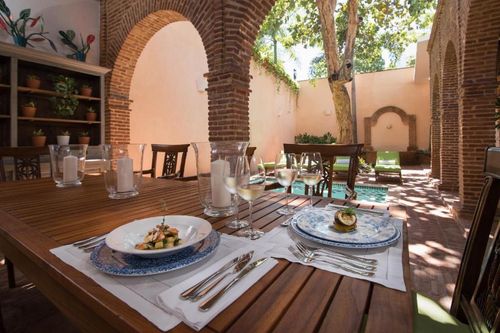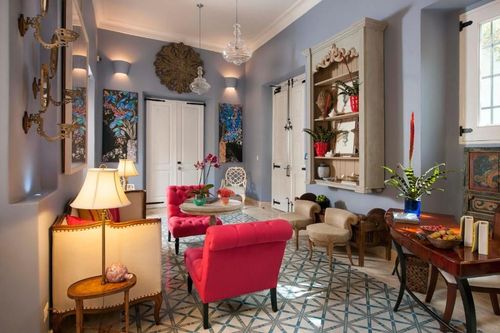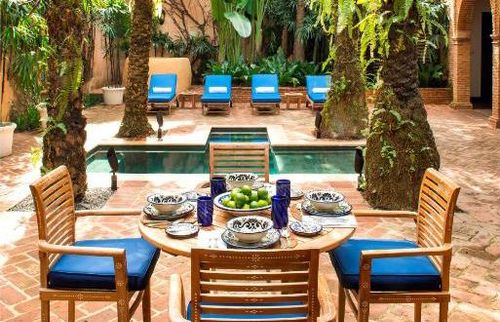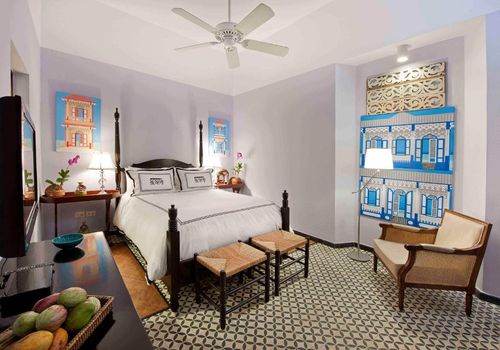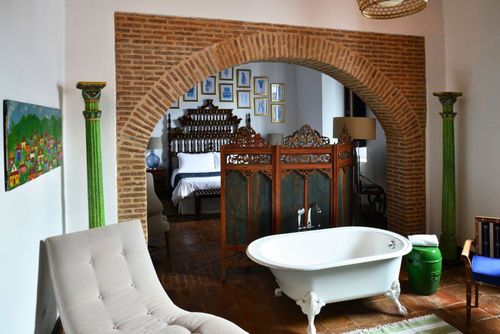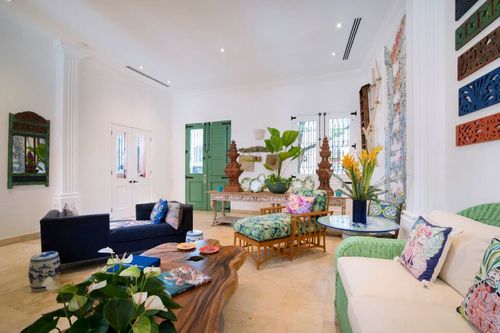In the heart of the pedestrianised Calle de Las Damas, you can admire the old fortress Fuerte Del Homenaje (nicknamed "Fortaleza"), the Casa de Bastidas and the Palacio de los Capitanes, the Casa de Ovando, which houses a superb hotel, and its famous Gothic-Isabellian gateway.
Named Nueva Isabela after Queen Isabella of Castile, Spain, the first city in the New World was founded on 4 August 1496 by Bartolomeo Columbus, Columbus' brother and governor of the island of Hispaniola. For the record, it was he who gave his name to the French island of Saint-Barthélemy. Built on the east bank of the River Ozama, it was destroyed by a hurricane and rebuilt in 1502 on the east bank of the river by Nicolas de Ovando. It was then named Santo Domingo de Gúzman, in honour of Saint Dominic de Guzmán, the founder of the Dominican order. A checkerboard plan was chosen for the construction of this city, which today is the recently restored district of the colonial zone.
A true city within a city, classified by UNESCO, this district is the historic enclave of the capital of the Dominican Republic and the richest in monuments. It covers just 3 km², but makes for some great walking. Its cobbled streets and centuries-old facades of colourful colonial houses provide the backdrop for picturesque bars and cafés, restaurants and hotels, some set in the heart of historic monuments. You'll need half a day to visit the area at a leisurely pace. If you're not in a hurry, take a horse-drawn carriage! But it's just as good to stroll around in the evening, when the bars come alive and the monuments are lit up.
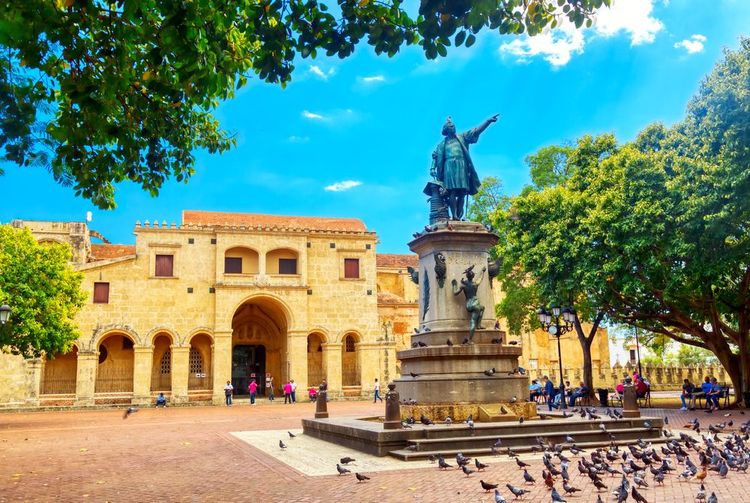
Statue of Christopher Columbus in front of the Cathedral of Santa Maria la Menor.
- © Nick N A / Shutterstock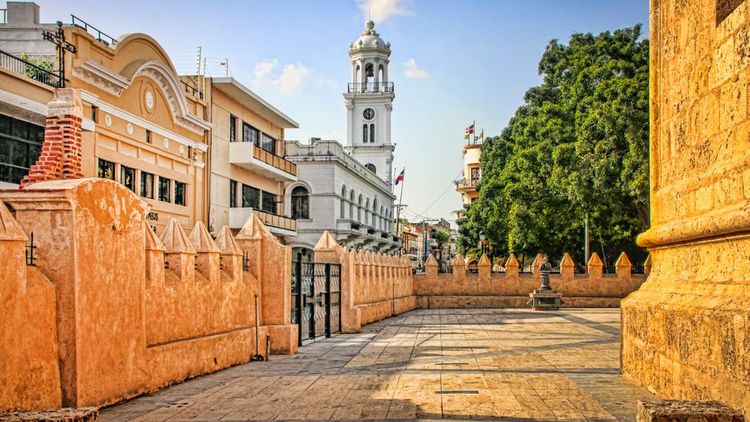
Its cobbled streets and century-old facades of colonial houses provide the backdrop for cafés, restaurants and hotels, some of which are located in the heart of monuments.
- © Daniel Andis / ShutterstockCalle Isabela la Catolica is home to the cathedral of Santa Maria la Menor, built in 1518 and the oldest in the Americas (an emblematic monument on the island), the Palacio de Borgella, the imposing ruins of the San Francisco monastery, the Casa Del Duarte and the Church of Santa Barbara.

The low-slung houses of the colonial town, some built of wood, stand in stark contrast to the high-rise buildings of the modern city.
- © Raphaël Richard / EASYVOYAGEIn Calle Padre Billini, don't miss the Regina Angelorum church, which took over 200 years to build, the Los Dominicos church, home to the first university in the Americas, the Casa de Tostado, the Santa Clara church, the Casa de Las Monedas and, finally, the Tapao house and the legend of the mysterious masked man. The Alcázar de Colón, the first cathedral in America, the Ozama Fortress, the Las Casas Reales Museum, the National Botanical Garden, the Malecon and the Palace of Fine Arts are the seven wonders of the Dominican capital included in the "Representative List of World Cultural Heritage Treasures".
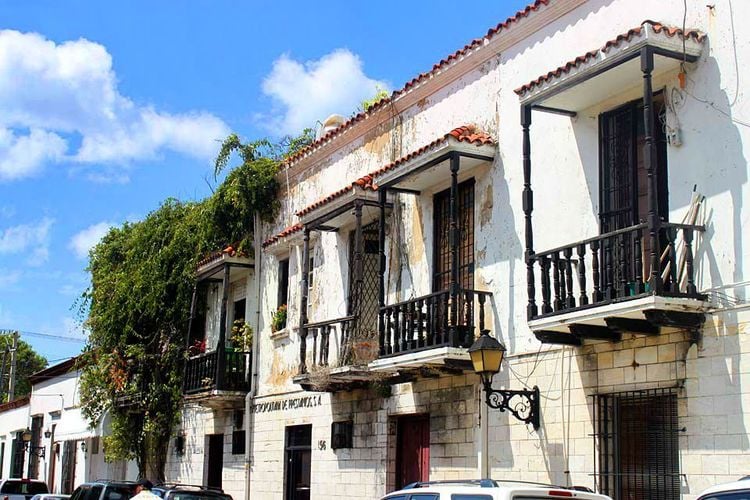
The colonial center doesn't resemble a museum town, and is still very much alive.
- © Raphaël Richard / EASYVOYAGESanto Domingo Cathedral
Santa Maria la Menor, also known as Our Lady of the Incarnation and Catedral Primada de América, was the first cathedral built in the New World. Construction began in 1523 and was completed in 1541, with the exception of the bell tower, which was never built. It was initially built of rammed earth and covered with palms. The floor is brick and the furniture is solid mahogany.
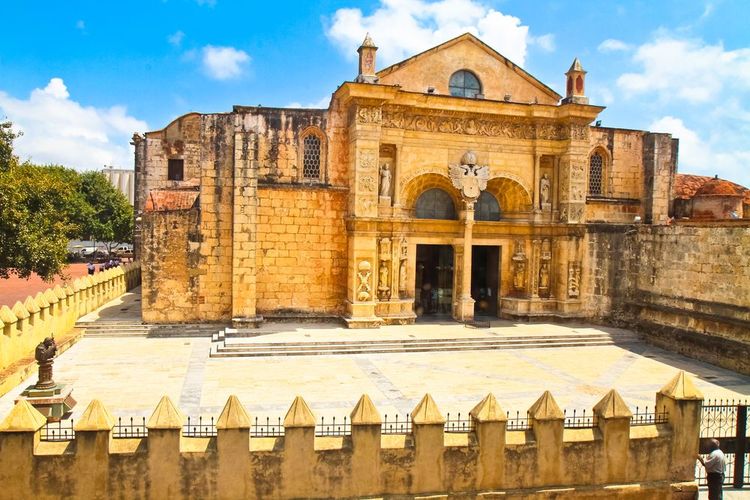
The main portal is adorned with an enormous door weighing 2.5 tonnes, dating from its creation and restored for the 500th anniversary of the discovery of America. The exterior is Renaissance in style, with Gothic vaults. Its façade of ochre coral stone and its priceless silver altar set it apart from the rest.
The cathedral has several styles, as it was built over several periods and has been renovated many times, following numerous earthquakes. For a month, it served as the headquarters of the English privateer Sir Francis Drake, who sacked Santo Domingo in 1586. The guides like to point out the first chapel to the right of the altar, where Francis Drake is said to have hung his hammock and accidentally cut off the nose of a statue with a sabre!
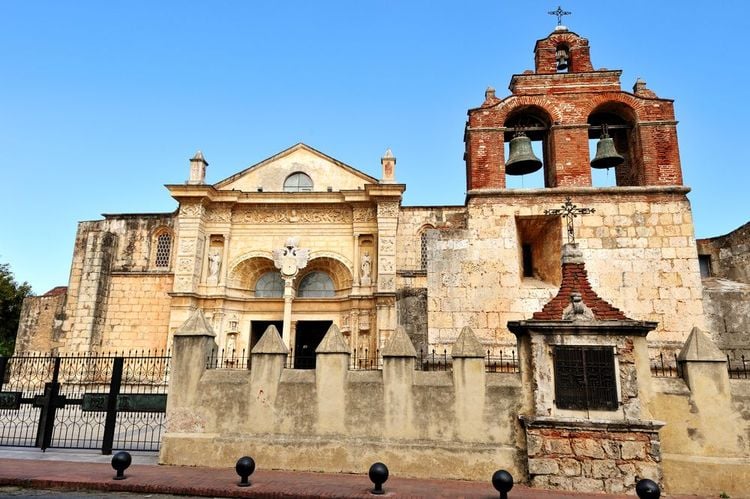
The cathedral's exterior façade
- © Zoran Karapancev / ShutterstockThe cathedral enclosed the remains of Christopher Columbus in a marble mausoleum in one of the 14 small interior chapels (according to his wishes), until he was transferred to Seville in 1785... or to the Columbus Lighthouse in 1992 (Spain and the Dominican Republic are vying for the honour of housing the remains of the illustrious navigator!). The cathedral dominates the Plaza de Colon (formerly the Plaza Mayor), in the middle of which stands the bronze and granite statue of Christopher Columbus, erected by the Frenchman Gilbert in 1887.
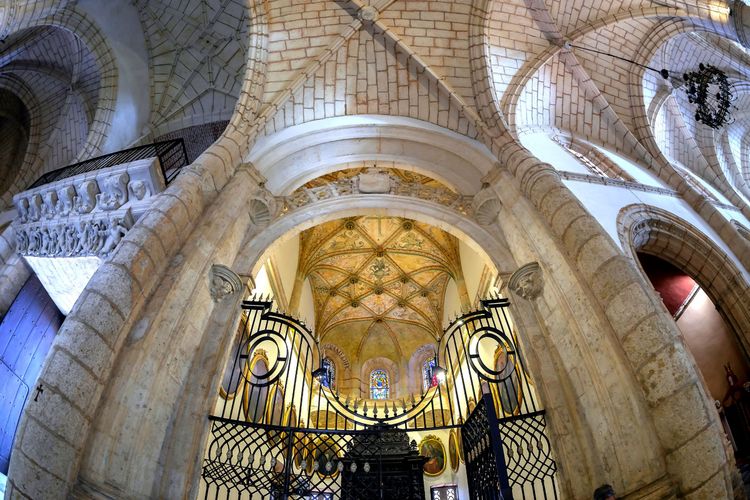
Gothic vaults inside the cathedral.
- © IOAN FLORIN CNEJEVICI / 123RFPleasant and shady, it is lined with numerous cafés, art galleries and cigar shops, and gives rise to El Conde, a long, lively pedestrian street with plenty of shops.
La calle del Conde
The calle del Conde is a meeting point for residents of the colonial zone and tourists alike, with an incredible number of bars, restaurants, fast-food outlets and shops of all kinds, from the puerta del Conde to the parque Colon and its cathedral.
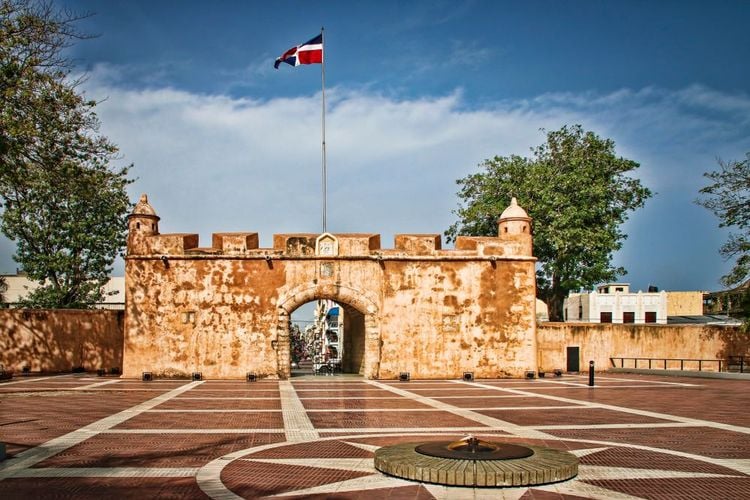
Puerta del Conde, 17th-century gateway to the old colonial wall and starting point of Calle del Conde.
- © Daniel Andis / ShutterstockThe only pedestrianised street in Santo Domingo, this never-ending commercial thoroughfare is teeming with life: a true strategic axis, it is the heart of the city. Shops line the cobblestones, and here and there you'll see old yellow number plates and other original knick-knacks. During your strolls through the colonial zone, you'll cross this thoroughfare many times. It was named after the Conde de Penalva (Count of Penalva), Governor of Hispaniola, who defended the city against the English in 1655.

At the end of the pedestrianised El Conde street, the Puerta del Conde, a 17th-century gateway and remnant of the old colonial wall, marks kilometre 0 of the Dominican Republic. This majestic fortified gate guards the Independence Park, which houses the Altar de la Patria, the mausoleum where the remains of the founding fathers of the Patria are laid to rest: Duarte, Sanchez and Mella. A perpetual flame commemorates the three founding fathers of the nation. On 27 February 1844, they declared Independence here, giving birth to the Dominican Republic.
The Alcázar de Colon
The seat of the Spanish crown in the New World for sixty years, the Alcázar de Colon played a strategic role in the Spanish conquest and colonisation of America.
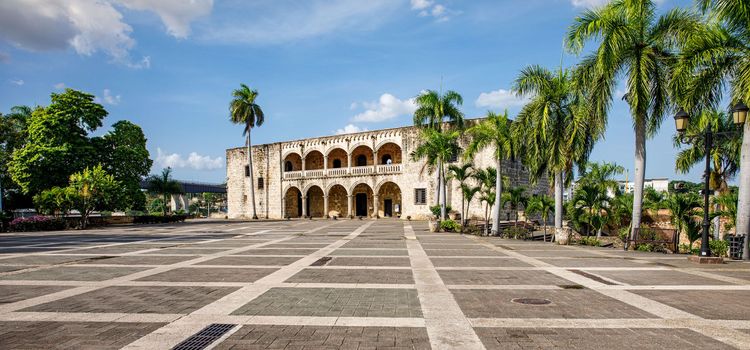
The Alcazar de Colon, a fortress palace that served as the viceroy's residence, now houses a museum.
- © Aleksandr Rybalko / ShutterstockIt was from here that Cortez, Pizarro, Balboa and Velazquez planned their conquests of Mexico, Peru, Panama and Cuba respectively. The residence of Diego Columbus, Viceroy of the Indies and son of the famous navigator, the Alcazar de Colon was built from coral rock (like the cathedral) in a blend of Mudejar and Gothic styles between 1510 and 1514 with the help of 1,500 indigenous people. Not a single nail was used to build the 22 rooms, 72 doors and windows of the first European-style palace in the New World, restored in 1955.
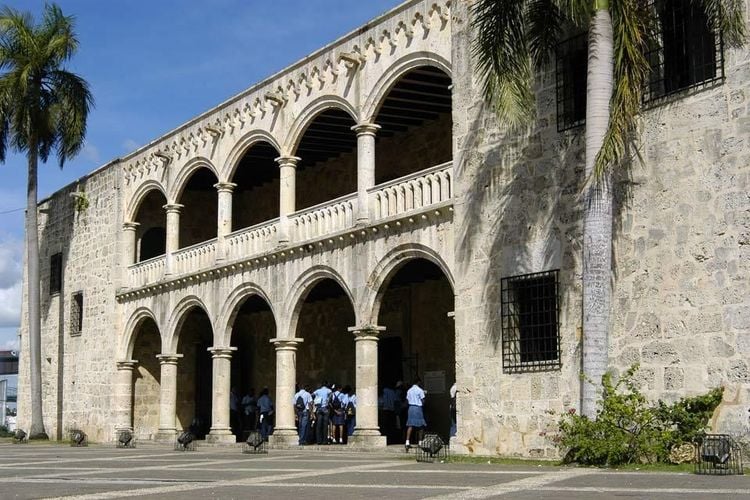
In front of the Alcazar de Colon, the vast Plaza de España regularly hosts cultural events
- © © Carlos Rodrigues / EASYVOYAGEAdorned with a palm tree at each end, the façade consists of five arches on each of the two levels. All the furniture, armour, paintings and religious objects on display inside date from the 15th and 16th centuries. To the rear, a garden overlooks the River Ozama. In the evening, the monument is beautifully illuminated and the square comes alive with joy. A giant Christmas tree takes pride of place in December, and the terraces of the chic bars and restaurants housed in the splendid colonial buildings are always full. This is undoubtedly one of the most fashionable places in the colonial zone.

Inside the Alcazar, the rooms where Diego Colon and his family lived in the 16th century have been reconstructed.
- © Raphael RICHARD / EASYVOYAGE
The building that is now a museum has come a long way. It was first used as a prison, then as a warehouse, before being abandoned for two centuries.
- © Raphael RICHARD / EASYVOYAGE
The first European palace in the New World, the Alcazar has 22 rooms, all of which can be visited.
- © Raphael RICHARD / EASYVOYAGELa Fortaleza Ozama
Built between 1502 and 1507 on the orders of Governor Nicolas de Ovando to protect the city from pirate attacks, Fortaleza Ozama was the first European fortress and the first military building in America. A stone wall separates it from the River Ozama, from which the building takes its name. Access is via the famous Calle de las Damas, the first street in the New World. Inside, you can wander through a vast garden featuring a bronze statue of Don Gonzalo Fernandez de Oviedo, a famous 16th-century chronicler who wrote the first history of the Americas.
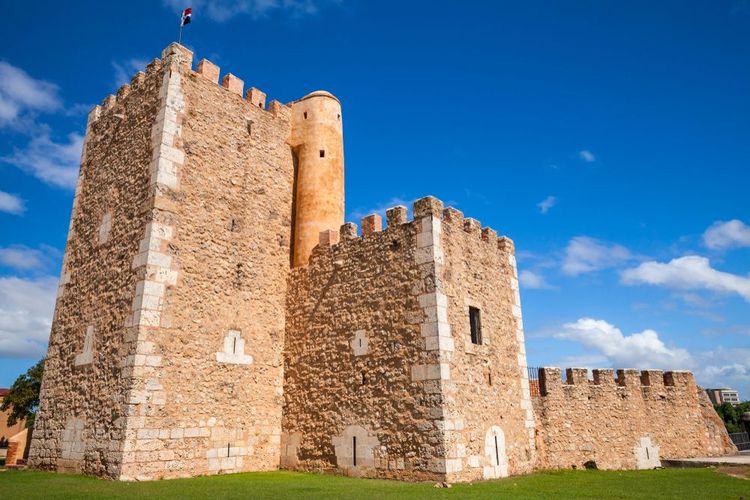
La Fortaleza Ozama
- © Evannovostro / ShutterstockThe complex is dominated by the Torre del Homenaje (Tribute Tower), a massive coral stone medieval keep. This square building dates from 1503 and contains a spiral iron staircase. From its 18-metre height, you can see the whole city and the river. Ships entering the port used to be greeted from the top of this tower, hence its name, the Homage Tower. In 1937, the dictator Trujillo reinforced it with a crenellated wall and used it as a prison until 1970. At the rear, the Carlos III gate is one of the oldest entrances to the fortress, which was never taken by force!
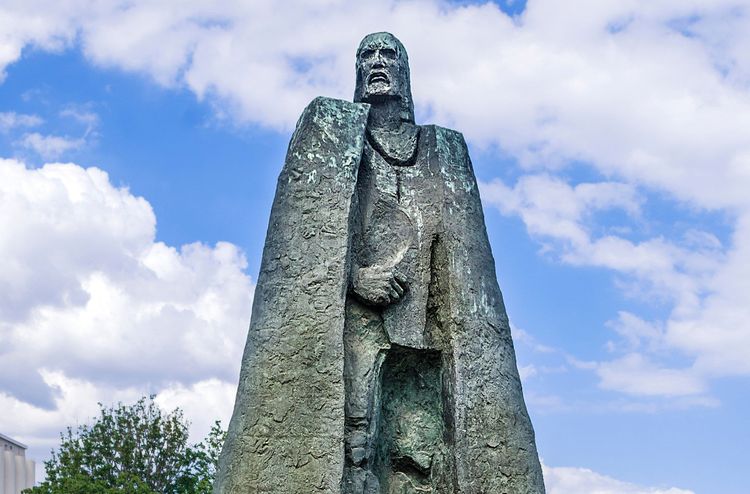
Bronze statue of Don Gonzalo Fernandez de Oviedo, author of the first history of the Americas.
- © dlrz4114 / 123RFThe monastery of San Francisco
Built in 1512 by monks of the Order of Saint Francis, the monastery of San Francisco was both the first monastery and the first centre of higher learning (1538) in the New World.
The Franciscans (and not the Dominicans) were the first religious to settle on the island of Hispaniola. They arrived on the second voyage of Christopher Columbus. Partly burnt down in 1586 when Sir Francis Drake destroyed the city, it barely survived an earthquake in 1673. Despite this, the impressive and moving ruins are still a popular place to take a stroll.
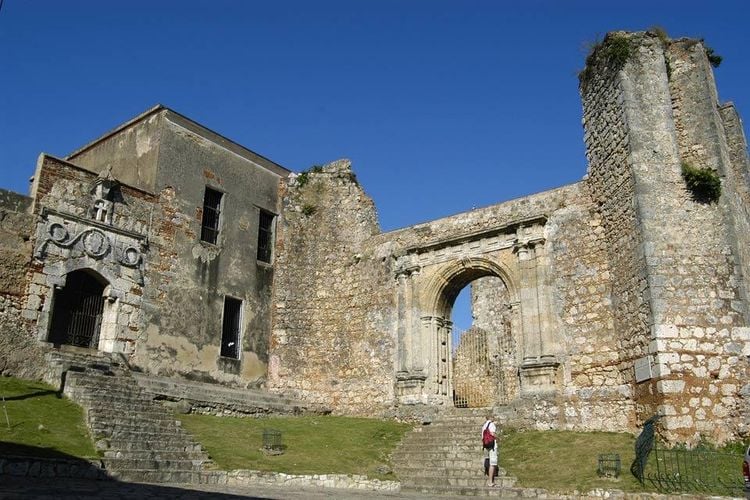
Ruins of the San Francisco monastery. The first monastery and center of higher learning in the New World. Impressive ruins can be admired today.
- © Carlos Rodrigues / EASYVOYAGENumerous concerts and cultural events are held at the foot of the building, which is surrounded by vast green spaces. A free concert is held in front of the San Francisco monastery every Sunday, come rain or shine! The old well and a reservoir where water was stored for the town's residents have survived. The site of the tomb of Alonso de Ojeda, one of the most intrepid captains of the conquistadores, can be seen beneath the ruined vault. Legend has it that, in an act of extreme humility, he asked to be buried at the entrance to the convent so that everyone could walk over him!
La Casa del Cordon
There are many 'Houses of the Cord' in the Hispanic world. Commissioned in 1502 by Don Francisco de Garay, a fellow traveller on Christopher Columbus's first expedition, the Casa del Cordon in Santo Domingo was the first stone house in the New World. The name of the house comes from the symbol of the Franciscan monk order: a rope belt carved on the façade.
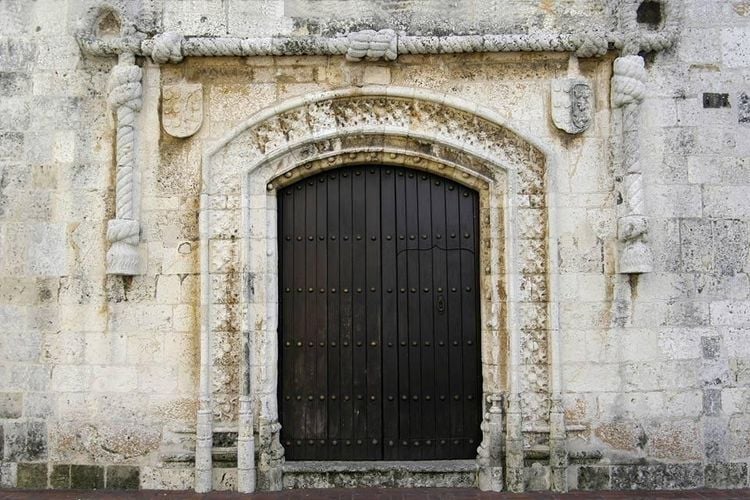
Casa del Cordon is considered the first house in the New World.
- © Carlos Rodrigues / EASYVOYAGELocated on Calle Isabel la Catolica opposite the Palace of Telecommunications, the Casa del Cordon now houses the Dominican Popular Bank, but don't hesitate to push open the sumptuous wooden door to discover its treasures: there is a magnificent collection of furniture from the colonial era, as well as a pretty patio. The only condition: it's forbidden to take photos!
Hotel Hodelpa Nicolas de Ovando
The former residence of the governor Nicolas de Ovando from 1502 to 1509 is one of the finest jewels in the colonial area, with its interior fountains, flower-filled patios, old stonework and period furniture, as well as views of the river from the terrace. Located in the heart of the colonial district on the first street of the New World, calle las Damas, this splendid palace with its Gothic-style portal (unique in America) is made up of three houses dating from the early 16th century.
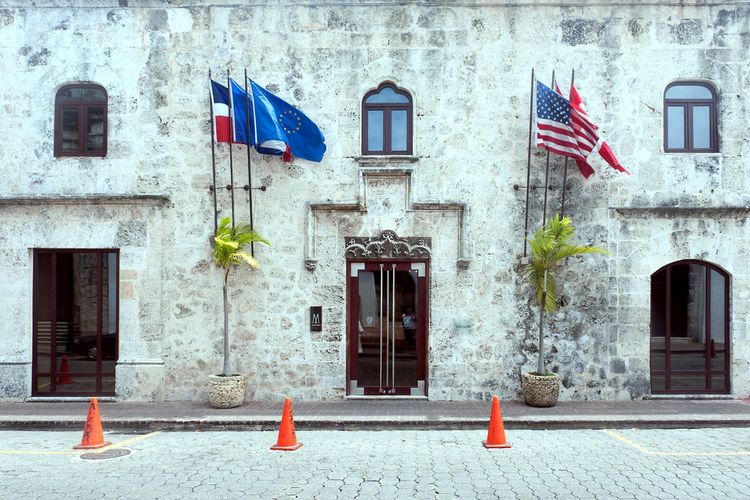
Hotel Hodelpa Nicolas de Ovando.
- © Julien Ferret / EASYVOYAGEThe first governor of the city (and of the Americas), Nicolas de Ovando designed the architecture and gave it the name Santo Domingo. Accor has taken charge of restoring this palace, listed as a UNESCO World Heritage Site, and turned it into a remarkable boutique hotel with the Sofitel label, one of the group's flagship hotels. The colonial-style rooms offer superb views over the garden, the pool, the river or the famous Calle de las Damas. In addition to the swimming pool (unique in the colonial area), the Nicolas de Ovando has a modern fitness centre and a gourmet restaurant serving refined dishes. An unforgettable experience in a comfortable, fully-equipped environment set in 16th-century surroundings!
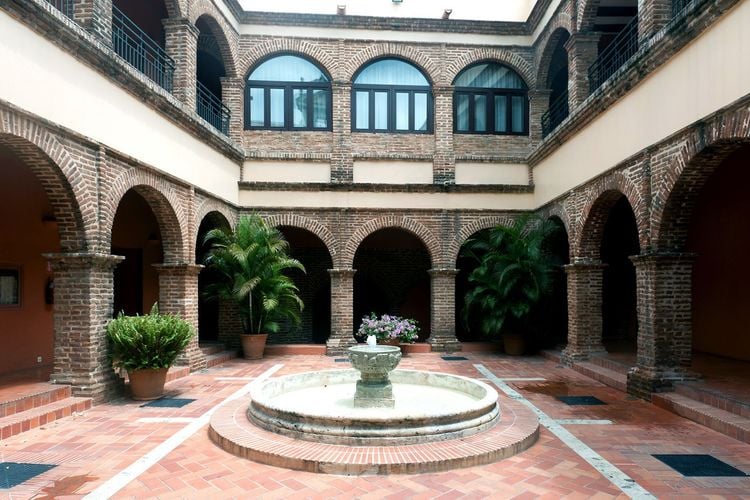
Patio of the Hotel Hodelpa Nicolas de Ovando.
- © Julien Ferret / EASYVOYAGE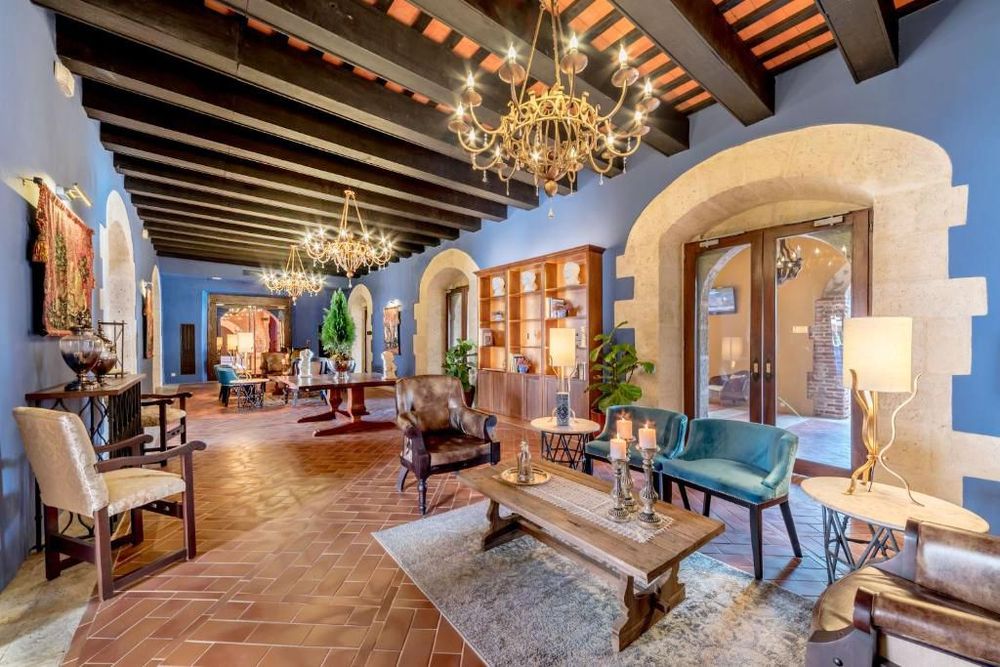 Santo Domingo
Santo Domingo
Hodelpa Nicolás de Ovando 5* - Santo Domingo
Typical hotel with outdoor swimming pool near the portThe National Pantheon
Opposite the Hotel Hodelpa Nicolas de Ovando, you can admire the National Pantheon, which houses the remains of heroes from Dominican history, particularly from the War of Independence. Formerly a Jesuit church built between 1714 and 1745, the building was successively a tobacco warehouse, a seminary and then a theatre in 1860 before being transformed into a Pantheon in 1955 by the dictator Trujillo. The central nave forms a cross with the side chapels.
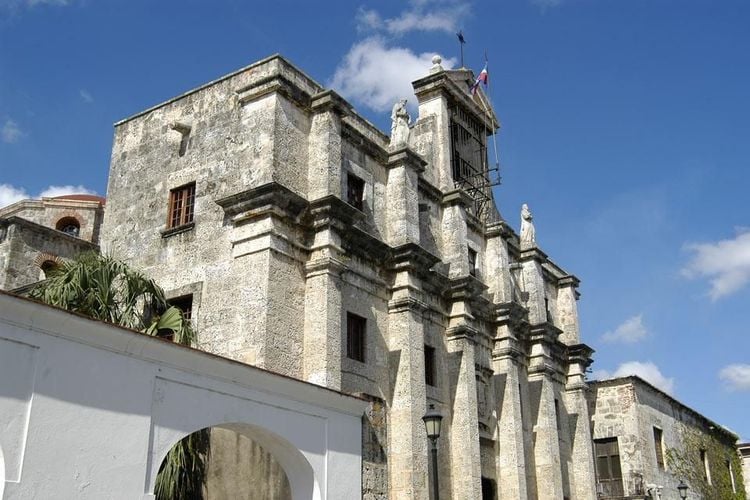
The façade of the National Pantheon contributes to the exceptional unity of the first paved street in the New World, Calle de las Damas
- © Carlos Rodrigues / EASYVOYAGE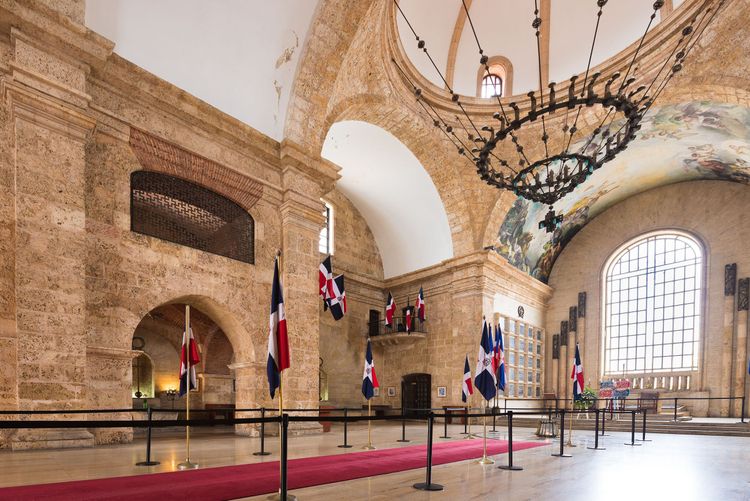
At the intersection is a dome from which hangs a majestic bronze chandelier given to the dictator Trujillo by his Spanish counterpart Franco.
- © Ggfoto / 123RF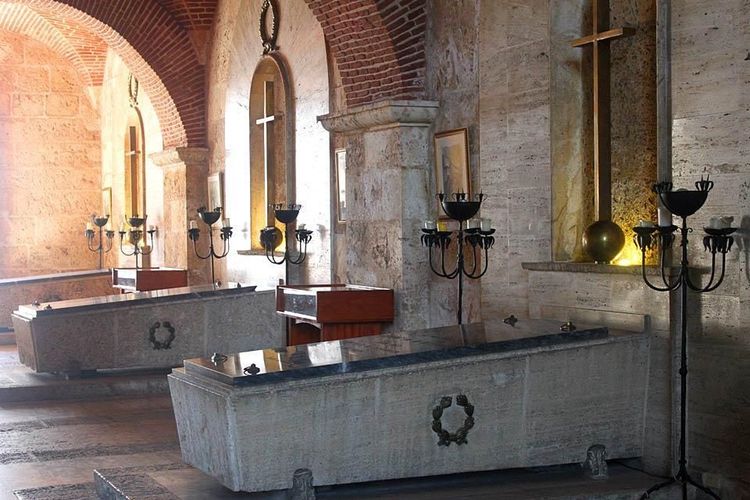
The tombs of the Panthéon National. For the Dominicans, the Santo Domingo National Pantheon is a place of meditation and official ceremonies.
- © Raphaël RICHARD / EASYVOYAGECalle de las Damas
Particularly well restored, the first street of the New World owes its name to the ladies of the court who used to stroll along it, in particular Maria de Toledo, vice-regent of the colony, niece of the King of Spain and wife of Diego Columbus, the son of the illustrious navigator. Today, visitors can follow in the footsteps of these ladies along this superb street, full of charm, for a real journey through time, which seems to have come to a standstill in this very peaceful place, barely disturbed by the few children playing along its picturesque facades.
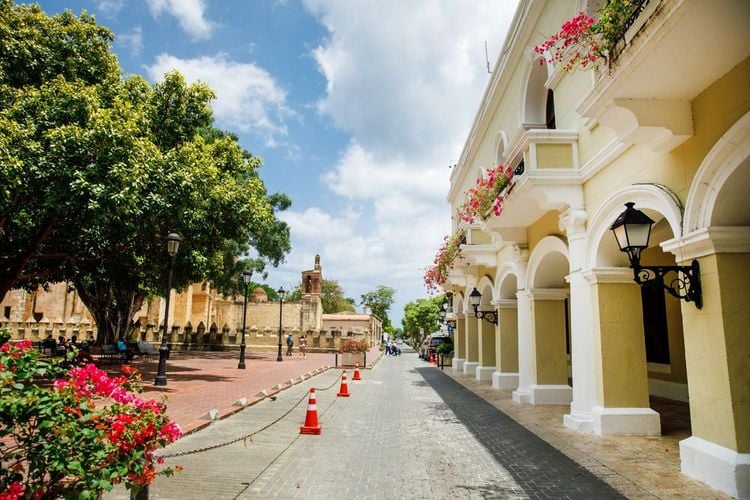
Calle de las Damas, the first street in the New World.
- © Aleksandr Rybalko / ShutterstockCalle Las Damas is lined with numerous colonial houses and several interesting buildings. It starts at the Plaza de Espana, where the Alcazar de Colon stands. As well as the casa de Ovando, the Ozama fortress and the chapel of Nuestra Senora de Los Remedios, it is home to the casa de Francia, an early 16th-century Gothic building that originally belonged to Governor Nicolas de Ovando. Hernan Cortés prepared his expedition to Mexico here. Renovated in 1932, it was loaned for fifty years to France in 1978, which used it as a cultural centre before moving its embassy there.
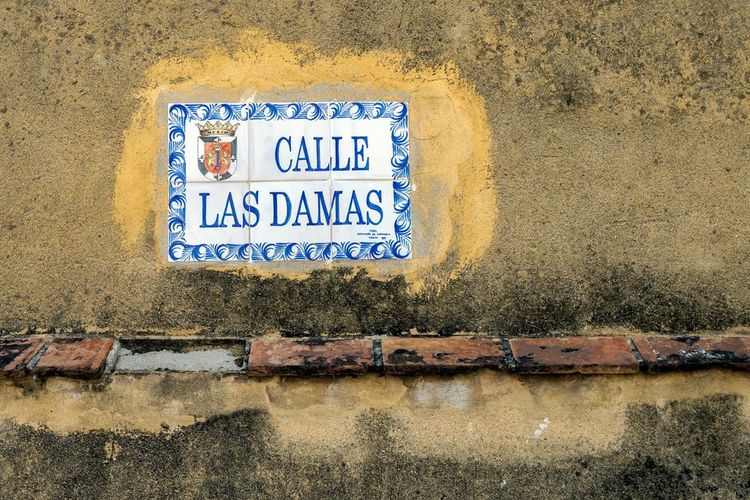
Opposite the Hotel Hodelpa Nicolas de Ovando, you can admire the National Pantheon, which houses the remains of heroes from Dominican history, particularly from the War of Independence. At the end of Calle las Damas on the way to the Plaça de l'Alcazar de Colon, you can see a sundial built in 1753 on the orders of Governor Francisco Rubio y Penaranda, and framed by four cannons.
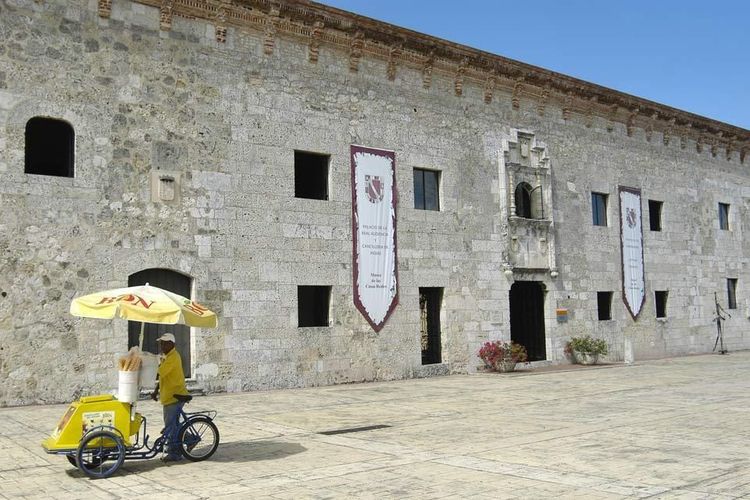
Calle de las Damas is home to many historic buildings.
- © Carlos Rodrigues / EASYVOYAGEWhere to sleep in the colonial zone?
🛌 Hodelpa Nicolas de Ovando
The legendary address in the Dominican capital, a real gem in the heart of Santo Domingo's colonial zone, a UNESCO World Heritage Site. The Hostal Nicolas de Ovando is a 16th-century palace, the former home of the first Governor of the Americas. For lovers of old stones, it offers a grandiose stopover with character. Luxury, tranquillity, beauty... You can't help but fall for the charms of this monument, which also boasts a beautiful swimming pool and the finest restaurant. A plunge into the heart of the colonial zone of the first city of the Americas, on the banks of the river.
🛌 Hodelpa Caribe Colonial
This boutique hotel ideally located in the heart of Santo Domingo's colonial zone is just 100 metres from the first cathedral in the Americas! It offers modern comfort with a lobby bar restaurant and free Internet access. An excellent address for exploring the treasures of the first city of the New World. It's also an opportunity to improve your wisdom by reading the many proverbs inscribed on the walls of the hotel! The guest book is full of compliments, particularly about the service provided by the staff and the suites. The minimalist blue-and-white decor and modern furniture are in the Art Deco style. On the roof, a solarium terrace offers beautiful views of the colonial quarter. You can relax on a deckchair and order food or drinks!
🛌 Casas del XVI Boutique Hotel
A luxury boutique hotel in the heart of Santo Domingo's colonial quarter. Nestled in the heart of Santo Domingo's colonial quarter, Casas del XVI is a luxurious boutique hotel full of charm. It features an exclusive collection of colonial houses dating back to the Conquistadors! Beautifully renovated, they house 21 rooms in six houses adorned with period brick arcades and palm tree lawns. Four of them have a swimming pool. A butler is also available. A jewel bearing the Small Luxury Hotels of the World label, ideally located for exploring the first city of the New World!
 Santo Domingo
Santo Domingo
Casas del XVI
Charming boutique hotel in Santo DomingoPractical information
🐴 Getting around
The colonial zone is easily traversed on foot. Forbid the car or taxi and discover all its treasures as you stroll around its narrow streets with their colourful facades and balconies overflowing with bougainvillea, unless you prefer a horse-drawn carriage or the colonial chu chu, a small tourist train that allows you to admire the main points of interest in the colonial quarter in 45 minutes.
🍽 Where to eat
Calle del Conde is full of souvenirs of all kinds, the most original being these old number plates laid out on the ground! On the other hand, avoid the overpriced restaurants for tourists on Calle del Conde, and lose yourself in the surrounding alleyways where you'll find small, unpretentious addresses frequented by locals. The food is very decent and hearty at ridiculously low prices (€3, including beer!) In the evening, you can listen to local music in one of the many club bars, and a free concert is held in front of the San Francisco monastery every Sunday, come rain or shine!
🚠 The cable car
Don't hesitate to take the Caribbean's first urban cable car, inaugurated in June 2018, whose full five-kilometre journey passes over the Ozama River twice, offering a superb panorama.
